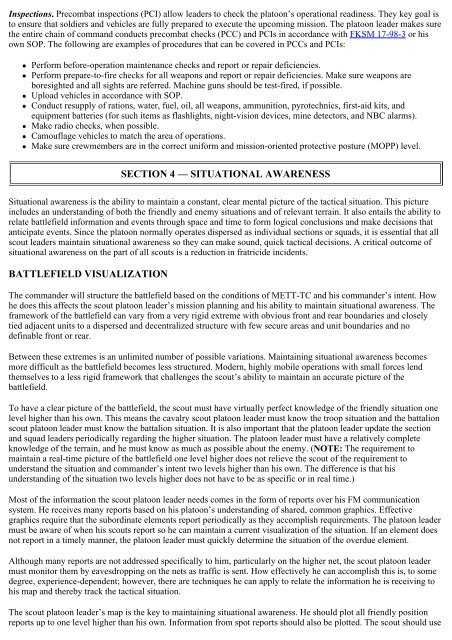FM 17-98 SCOUT PLATOON
FM 17-98 SCOUT PLATOON
FM 17-98 SCOUT PLATOON
You also want an ePaper? Increase the reach of your titles
YUMPU automatically turns print PDFs into web optimized ePapers that Google loves.
Inspections. Precombat inspections (PCI) allow leaders to check the platoon’s operational readiness. They key goal is<br />
to ensure that soldiers and vehicles are fully prepared to execute the upcoming mission. The platoon leader makes sure<br />
the entire chain of command conducts precombat checks (PCC) and PCIs in accordance with FKSM <strong>17</strong>-<strong>98</strong>-3 or his<br />
own SOP. The following are examples of procedures that can be covered in PCCs and PCIs:<br />
• Perform before-operation maintenance checks and report or repair deficiencies.<br />
• Perform prepare-to-fire checks for all weapons and report or repair deficiencies. Make sure weapons are<br />
boresighted and all sights are referred. Machine guns should be test-fired, if possible.<br />
• Upload vehicles in accordance with SOP.<br />
• Conduct resupply of rations, water, fuel, oil, all weapons, ammunition, pyrotechnics, first-aid kits, and<br />
equipment batteries (for such items as flashlights, night-vision devices, mine detectors, and NBC alarms).<br />
• Make radio checks, when possible.<br />
• Camouflage vehicles to match the area of operations.<br />
• Make sure crewmembers are in the correct uniform and mission-oriented protective posture (MOPP) level.<br />
SECTION 4 — SITUATIONAL AWARENESS<br />
Situational awareness is the ability to maintain a constant, clear mental picture of the tactical situation. This picture<br />
includes an understanding of both the friendly and enemy situations and of relevant terrain. It also entails the ability to<br />
relate battlefield information and events through space and time to form logical conclusions and make decisions that<br />
anticipate events. Since the platoon normally operates dispersed as individual sections or squads, it is essential that all<br />
scout leaders maintain situational awareness so they can make sound, quick tactical decisions. A critical outcome of<br />
situational awareness on the part of all scouts is a reduction in fratricide incidents.<br />
BATTLEFIELD VISUALIZATION<br />
The commander will structure the battlefield based on the conditions of METT-TC and his commander’s intent. How<br />
he does this affects the scout platoon leader’s mission planning and his ability to maintain situational awareness. The<br />
framework of the battlefield can vary from a very rigid extreme with obvious front and rear boundaries and closely<br />
tied adjacent units to a dispersed and decentralized structure with few secure areas and unit boundaries and no<br />
definable front or rear.<br />
Between these extremes is an unlimited number of possible variations. Maintaining situational awareness becomes<br />
more difficult as the battlefield becomes less structured. Modern, highly mobile operations with small forces lend<br />
themselves to a less rigid framework that challenges the scout’s ability to maintain an accurate picture of the<br />
battlefield.<br />
To have a clear picture of the battlefield, the scout must have virtually perfect knowledge of the friendly situation one<br />
level higher than his own. This means the cavalry scout platoon leader must know the troop situation and the battalion<br />
scout platoon leader must know the battalion situation. It is also important that the platoon leader update the section<br />
and squad leaders periodically regarding the higher situation. The platoon leader must have a relatively complete<br />
knowledge of the terrain, and he must know as much as possible about the enemy. (NOTE: The requirement to<br />
maintain a real-time picture of the battlefield one level higher does not relieve the scout of the requirement to<br />
understand the situation and commander’s intent two levels higher than his own. The difference is that his<br />
understanding of the situation two levels higher does not have to be as specific or in real time.)<br />
Most of the information the scout platoon leader needs comes in the form of reports over his <strong>FM</strong> communication<br />
system. He receives many reports based on his platoon’s understanding of shared, common graphics. Effective<br />
graphics require that the subordinate elements report periodically as they accomplish requirements. The platoon leader<br />
must be aware of when his scouts report so he can maintain a current visualization of the situation. If an element does<br />
not report in a timely manner, the platoon leader must quickly determine the situation of the overdue element.<br />
Although many reports are not addressed specifically to him, particularly on the higher net, the scout platoon leader<br />
must monitor them by eavesdropping on the nets as traffic is sent. How effectively he can accomplish this is, to some<br />
degree, experience-dependent; however, there are techniques he can apply to relate the information he is receiving to<br />
his map and thereby track the tactical situation.<br />
The scout platoon leader’s map is the key to maintaining situational awareness. He should plot all friendly position<br />
reports up to one level higher than his own. Information from spot reports should also be plotted. The scout should use











